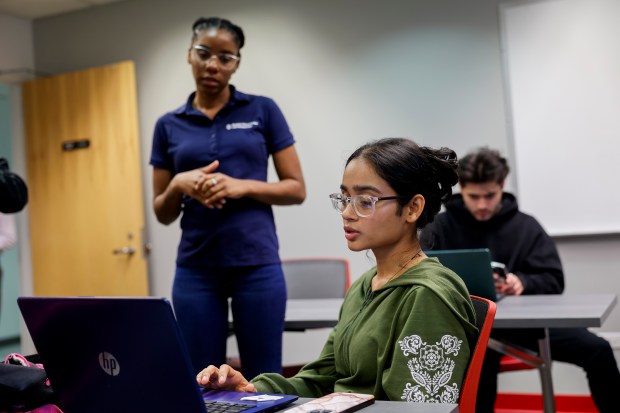After a delayed launch that set the timeline back by months, the overhauled Free Application for Federal Student Aid is off to a complicated start.
The FAFSA, which typically opens in October, didn’t become available until Dec. 31, after the government revised the form and changed the formula for student aid in an attempt to make it easier to file. And the new form was hard to access for several weeks.
The changes created a tighter timeline for students, especially those filing for financial aid for the first time, and a time crunch for colleges, which won’t get student information until mid-March at the earliest.
The new, streamlined FAFSA still has some kinks: One of its largest issues has made it difficult for applicants whose families do not have Social Security numbers to start or access the 2024-25 FAFSA form.
The glitch has caused collateral pain, according to Jack Wallace, the head of government affairs and industry relations at Yrefy, a Phoenix-based student loan provider. “Not only do you have students having a difficult time still getting on the website and getting things processed on the front end, but there’s also a delay in getting the data to the schools,” Wallace said.
Applicants should fill out the FAFSA as early as possible, but don’t rush through it, and be sure to do it right, Wallace said. “You only get one shot at getting it done and getting it done correctly,” he said. “If you make mistakes on it and get kicked out, it’s only going to delay your financial aid and decision processing even more.”
Illinois requires all public high school seniors to complete the FAFSA, despite their income. There are many things to know about completing the form this year.
The form is online at StudentAid.gov. You’ll need to create a Federal Student Aid or FSA ID, an online login with a username and password, for the U.S. Department of Education.
There are a few ways the experience will be different for the 2024-25 application, according to Wallace, who said he met with Department of Education officials earlier this month.
The application is shorter, but not necessarily easier. “The biggest change is that it is supposed to be a more simple application process because they cut the questions almost in half,” Wallace said.
He added that fewer questions means less time spent filling out the forms. The 2024-25 FAFSA has 36 questions, and much of the information will be pulled directly from federal income tax returns.
There is a new IRS tool. As a part of the new form, applicants must provide consent and approval to import their federal tax information directly from the IRS, a move meant to simplify the process, according to Wallace. However, your family’s 2022 taxes must be completed before importing the tax information.
If you are not a tax filer, there will be a code that the IRS will fill in that indicates you don’t have a tax return on file, Wallace said. “People won’t have to worry about whether or not they’re putting in the right numbers,” he said.
“Contributor” is a new term on the form. A contributor refers to anyone asked to provide Federal tax information on a student’s FAFSA form. Contributors are only the student, the student’s spouse, a biological or adoptive parent, or a stepparent. Even though grandparents, aunts, uncles or other relatives may have raised or provided for the student, they aren’t considered contributors unless they have legally adopted the student.
A student can be their own contributor if they file their taxes independently or are single and financially independent. A contributor can also be a person who claims the student as a dependent on their taxes. Spouses can be contributors, too, if they file their taxes jointly.
Despite the name, contributors aren’t required to contribute to the student’s tuition, Wallace said. Failure to account for and list contributors could result in problems and delays, Wallace said.
Know which contributors should be included on the FAFSA form. A series of questions on the FAFSA form designed to determine whether you’re a dependent or an independent student will tell you who needs to be a contributor based on your answers. Applicants will also answer questions about their personal circumstances. If you’re considered a dependent student, your parents — or the person that the state has determined to be your legal parent — will be identified as a contributor.
What contributors have to do on the FAFSA form. Contributors will receive an email informing them that they have been identified as a contributor on a FAFSA form. Then the contributor will log in to the account using their username and password to provide the required information on the student’s form. Wallace suggests that contributors fill out their portion of the form sooner.
If your family members don’t have a Social Security number, you can still apply for FAFSA but it will be a longer process. The Department of Education announced on Tuesday new guidelines for students from families with mixed immigration statuses while it fixes technical issues.
“We have a lot of students who are coming to us whose families don’t have social security numbers, they are hitting almost a full stop,” said Kiely Fletcher, vice provost of enrollment management at the University of Illinois Chicago. “They’re getting error messages — they’re having significant issues just based on workshops we’ve had.”
Fletcher said some students whose families don’t have an SSN are being prompted to upload documents on the FAFSA site that will be reviewed in two weeks’ time.
Parents without an SSN can create a StudentAid.gov account by selecting the “I don’t have a Social Security number” checkbox at the beginning.
Wallace noted that accounts created without an SSN have limited functionality. The form will also ask those creating an account without an SSN to answer questions that will be used to verify the applicant’s identity.
According to information found on StudentAid.gov/FAFSA, the only people who should create an account without an SSN are a student’s parent or spouse who doesn’t have an SSN or a student who’s a citizen of the Freely Associated States of the Pacific and needs to complete the FAFSA form online. Most students who are in the country without legal permission aren’t eligible for an SSN and therefore cannot complete the FAFSA form, according to StudentAid.gov.
If you’re a student with a contributor who doesn’t have an SSN, follow these steps. Once students complete their section of the form, those with a parent without an SSN should select the link to enter their contributor’s information manually. Once you apply your signature, you’ll see the “You’re Almost There!” page, which indicates your section of the form is complete. Go to the bottom of this page, past “Things You Should Know,” and select the link to enter your contributor’s information manually.
Fill in all information associated with your contributor who does not have an SSN. You must manually enter their income and tax information, including their adjusted gross income and income taxes paid. You may need a copy of their 2022 federal tax return to complete this section.
If you have only one required contributor (either a parent or spouse), you will see a “Submit” button at the bottom of the Review Form page. Select: “Take a Moment to Review Before Signing.” Hit “Submit” to file the form without the signature of the contributor who does not have an SSN. A pop-up window will warn you that the form is missing your contributor’s consent but simply select “Submit” again to move past that message.
Visit studentaid.gov//fafsa-support/pro-tips for more information.
FAFSA Submission Summary is the new Student Aid Report. After your FAFSA form is submitted and processed, you’ll receive an email with instructions on how to access an online copy of your FAFSA submission summary.
The summary will include an estimation of the amount of federal student aid that you may be eligible for. But aid offers will come directly from any schools you’ve listed on your FAFSA form and to which you have been accepted.
The Department of Education updated the supporting tables used in the Student Aid Index calculation — which replaced the Expected Family Contribution formula — that account for inflation. The updated tables will allow students to benefit from an additional $1.8 billion in aid and ensure that all students can access the maximum financial aid for which they are eligible, according to the department.
What to expect in the weeks and months after you file. Because schools won’t receive students’ FAFSA forms until mid-March, the timeline is further squeezed.
“We won’t be getting all of them in March,” Fletcher said. “They will be issuing batches to us — we don’t know how many batches we’re going to get or how many students are in those batches, and right now we have no line of sight to how many UIC students have filed for FAFSA.”
Fletcher said this will affect incoming first-year college students who might be waiting to receive financial aid offers from multiple schools before making a decision. She suggests keeping a close eye on both email and postal mail from each school, sending emails out to schools’ financial aid offices to establish a line of communication, and regularly checking each school’s financial aid website for updates.
Students will receive an email indicating that their FAFSA has been processed and sent to the colleges they listed. To be extra sure, log in to your Federal Student Aid account and check to see if you need to take any further steps.
Apply regardless of income. “About 85% of the people who fill out FAFSA get some sort of financial aid,” Wallace said. “You may not get a Pell Grant, but you never know at the state level or the federal level, if there’s some dollars out there that you might get. So regardless of what your family may make, people should fill out the form and see what happens.”
What is the deadline to apply? June 30 is the last day you can apply for financial aid for the upcoming school year.
More things to know: Your information can now be sent to up to 20 colleges, career schools or trade schools to receive federal aid. You should also regularly check the Federal Student Aid office’s webpage dedicated to announcements related to FAFSA for updates. Be aware that some schools are postponing their decision day deadlines. UIC, for example, is giving students who have been accepted until June 1 to commit. And when you have questions, the Federal Student Aid account on YouTube has helpful videos explaining the application, including common pitfalls: youtube.com/@FederalStudentAid.





